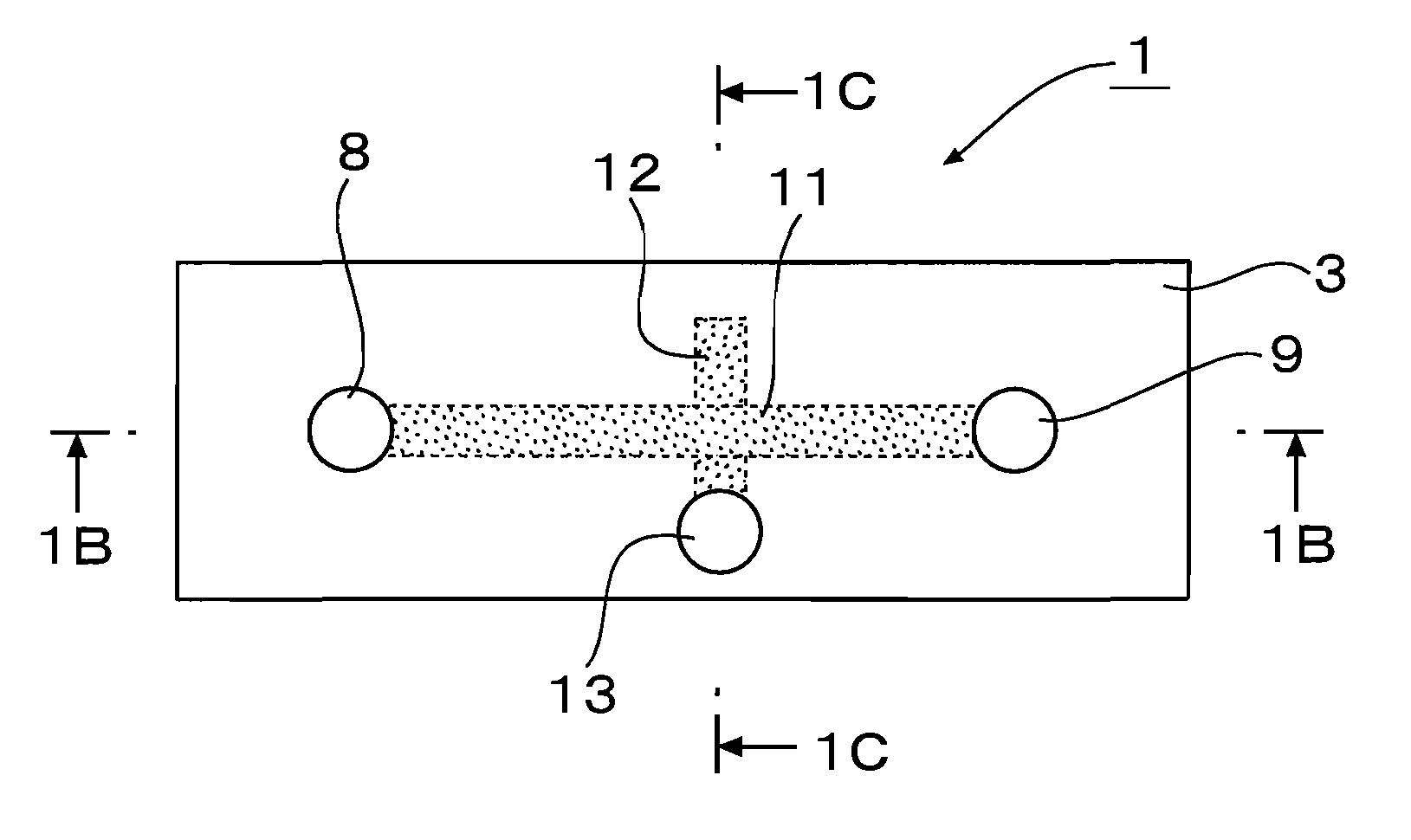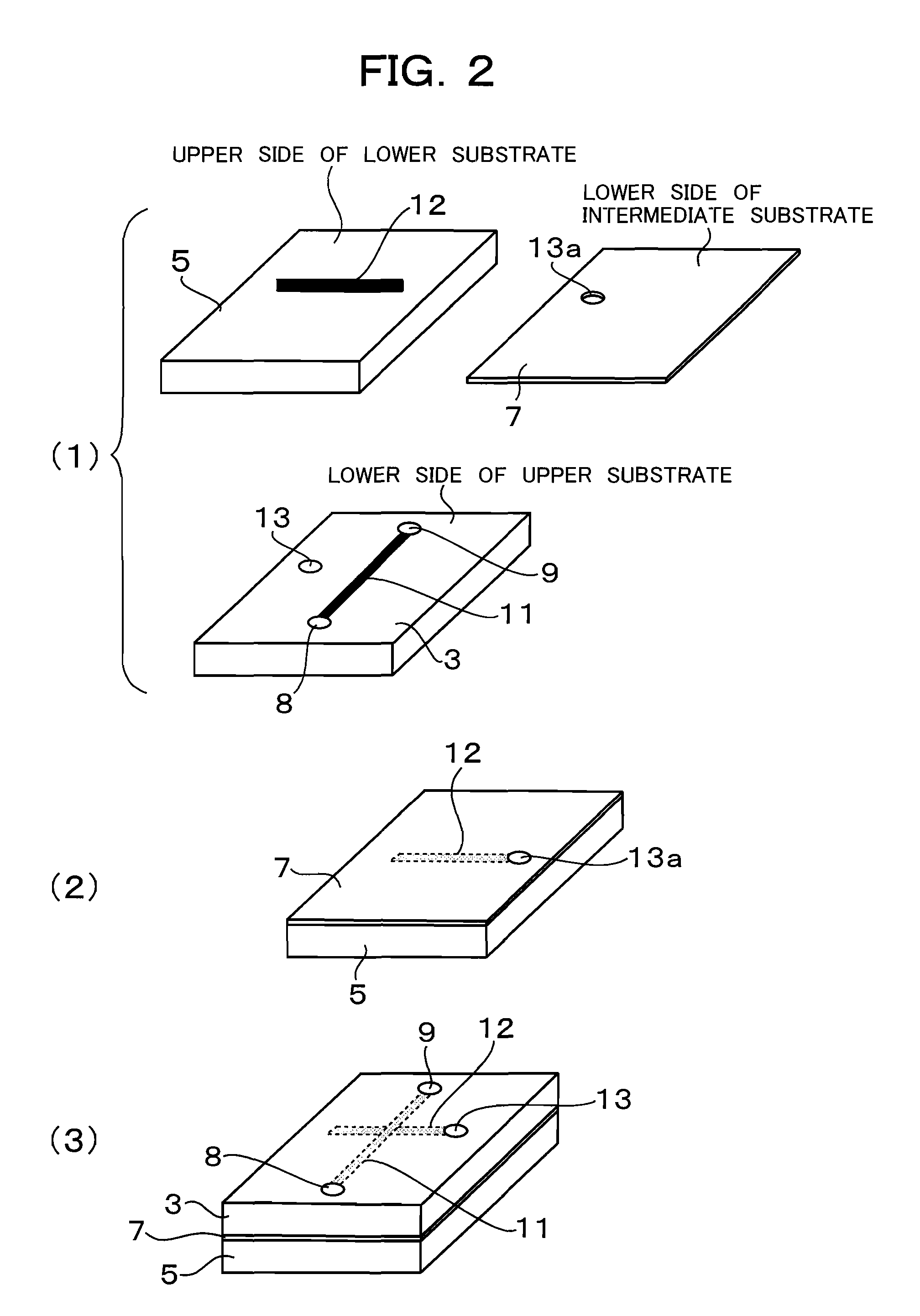Micro-channel chip and a process for producing the same
a microchannel chip and microchannel technology, applied in the direction of resistive material coating, metallic material coating process, electrical equipment, etc., can solve the problems of difficult shape of the fine tube, inability to produce film masks, and method that is even more sophisticated and expensive than is required to form the main channel, so as to achieve the effect of lower cost and higher yield
- Summary
- Abstract
- Description
- Claims
- Application Information
AI Technical Summary
Benefits of technology
Problems solved by technology
Method used
Image
Examples
example 1
(1) Fabrication of Micro-Channel Chips
[0074] According to the flowchart shown in FIGS. 5A and 5B, a micro-channel chip 1B was fabricated. First, in step (a), two masks were prepared, each with a channel design punched through. Mask 20 was intended for the non-adhesive thin-film layer 11 and it was formed by cutting scores (feature size, 400 μm) through a PET film 0.025 mm thick to give a pattern of predetermined design. Mask 21 was intended for the non-adhesive thin-film layer 12 and it was formed by cutting scores (feature size, 400 μm) through a PET film 0.025 mm thick to give a pattern of predetermined design.
[0075] Next, in step (b), the mask 20 was placed on the lower side of the upper substrate 3 with a thickness of 3 mm that was made of silicone rubber (PDMS); the mask 20 was then attached to this upper substrate 3 by means of self-adsorption. The other mask 21 was placed on the upper side of the lower substrate 5 with a thickness of 3 mm that was made of silicone rubber (P...
example 2
(1) Fabrication of a Micro-Channel Chip
[0082] (a) Using a mold prepared by the usual procedure of photolithography, a silicone-rubber made upper substrate was formed; it was 3 mm thick and had a groove with a fixed rectangular shape as a micro-channel. The micro-channel (groove) was 400 μm wide and 50 μm deep. The lower side of the upper substrate and the upper side of a 100 μm thick silicone-rubber made intermediate substrate were subjected to a treatment for surface modification by the same method as in Example 1; the lower side of the upper substrate was attached to the upper side of the intermediate substrate, whereby the upper substrate was permanently bonded to the intermediate substrate. Three holes were bored through the permanently bonded assembly in predetermined positions.
[0083] (b) A mask was formed by cutting scores (feature size, 400 μm) through a PET film 0.025 mm thick to give a pattern of predetermined design. The mask was then placed on the upper side of a lower ...
example 3
(1) Fabrication of a Micro-Channel Chip
[0086] A micro-channel chip 1C of the design shown in FIG. 6 was fabricated. When a plurality of liquid chemicals are successively transferred through different channels into a single reaction chamber where they undergo intended reactions, the liquid chemical that has flowed through one channel into the reaction chamber might occasionally flow back into another channel. This phenomenon can be effectively prevented by using a micro-channel chip having the structure shown in FIG. 6. A PDMS upper substrate 3 having a thickness of 3 mm is provided with three ports 8-1, 8-2 and 8-3 that are through-holes for introducing a liquid. The upper substrate 3 is also provided with a through-hole 23 and a port 9; the through-hole 23 is for inflating an area that corresponds to a non-adhesive thin-film layer 25 in an enlarged region so as to create a reaction chamber, and the port 9 is a through-hole for discharging a liquid. Further, the upper substrate 3 i...
PUM
| Property | Measurement | Unit |
|---|---|---|
| Adhesivity | aaaaa | aaaaa |
Abstract
Description
Claims
Application Information
 Login to View More
Login to View More - R&D
- Intellectual Property
- Life Sciences
- Materials
- Tech Scout
- Unparalleled Data Quality
- Higher Quality Content
- 60% Fewer Hallucinations
Browse by: Latest US Patents, China's latest patents, Technical Efficacy Thesaurus, Application Domain, Technology Topic, Popular Technical Reports.
© 2025 PatSnap. All rights reserved.Legal|Privacy policy|Modern Slavery Act Transparency Statement|Sitemap|About US| Contact US: help@patsnap.com



